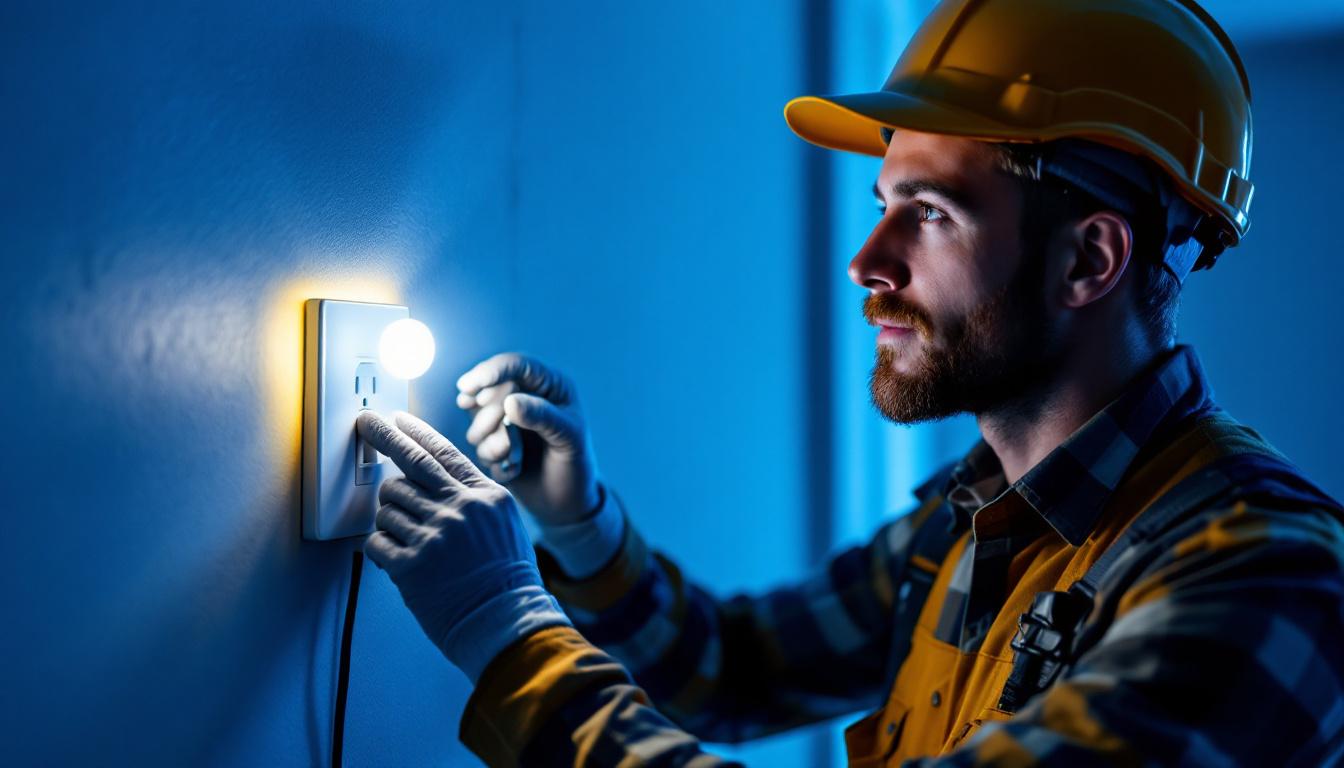
In the realm of commercial and residential lighting, emergency preparedness is a critical consideration. Plug in emergency lights with battery backup serve as a vital component in ensuring safety during power outages or emergency situations. For lighting contractors, understanding the nuances of these systems is essential not only for compliance with safety codes but also to deliver reliable solutions that protect lives and property.
Emergency lighting systems must provide immediate illumination to facilitate safe evacuation and prevent accidents. The integration of battery backup ensures that these lights remain operational even when the main power supply is interrupted. This reliability is a key selling point for contractors advising clients on safety upgrades or new installations.
Moreover, the design and placement of these emergency lights are crucial for maximizing their effectiveness. Strategically positioning lights in hallways, stairwells, and near exits can significantly enhance visibility during an emergency. Additionally, many modern plug-in emergency lights come equipped with features such as motion sensors and adjustable brightness settings, which can further improve their efficiency and adaptability in various situations. This attention to detail not only meets regulatory requirements but also provides peace of mind for occupants, knowing they are prepared for unforeseen events.
Furthermore, the technology behind battery backup systems has evolved significantly, with many units now incorporating LED technology. LEDs offer longer lifespans and lower energy consumption compared to traditional bulbs, making them an environmentally friendly choice. The ability to run for extended periods on battery power also means that these lights can remain functional long after a power outage begins, providing crucial illumination until help arrives or power is restored. For contractors, recommending energy-efficient solutions not only aligns with sustainability goals but also appeals to clients looking to reduce operational costs in the long run.
One of the primary advantages of plug in emergency lights is their portability and straightforward installation process. Unlike hardwired systems, these units can be plugged directly into standard electrical outlets, reducing labor costs and installation time. This feature is particularly beneficial in retrofit projects where existing wiring may be difficult to access or modify.
Additionally, plug in models allow for flexible placement and easy relocation, which can be advantageous in dynamic environments such as construction sites, event venues, or temporary workspaces. For instance, in a bustling event venue, lighting needs may change frequently based on the layout or type of event being hosted. The ability to quickly reposition emergency lighting ensures that safety measures are always in place, regardless of how the space is utilized. This adaptability not only enhances safety but also maximizes the utility of the lighting system, making it an invaluable asset for facility managers.
Battery backup technology in emergency lighting ensures continuous operation during power failures. Modern units typically utilize sealed lead-acid or lithium-ion batteries, which offer long service life and maintenance-free operation. Lighting contractors should emphasize the importance of battery quality and capacity to clients, as these factors directly impact the duration and effectiveness of emergency illumination.
Routine testing and maintenance protocols are also essential to verify battery health and system readiness. Many advanced plug in emergency lights feature self-diagnostic capabilities, alerting users when batteries need replacement or when faults are detected. This proactive approach not only helps in maintaining compliance with safety standards but also provides peace of mind, knowing that the emergency lighting system is always ready to perform when needed. Furthermore, some models come equipped with LED indicators that provide real-time status updates, allowing users to easily monitor the operational state of their emergency lighting systems.
Compliance with local and national safety codes, such as the National Fire Protection Association (NFPA) standards and the International Building Code (IBC), is non-negotiable in emergency lighting installations. Plug in emergency lights with battery backup must meet specific illumination levels, duration requirements, and placement criteria to be code-compliant.
Lighting contractors should stay current with evolving regulations to ensure that their installations pass inspections and provide the necessary protection. Offering clients certified products and documented testing procedures can enhance credibility and trust. Moreover, understanding the nuances of these codes can help contractors provide tailored solutions that not only meet but exceed regulatory expectations. This proactive approach can be a significant selling point, as clients increasingly seek assurance that their safety measures are robust and reliable. Additionally, engaging in regular training and certifications can keep contractors well-informed about the latest advancements in emergency lighting technology and compliance requirements, further solidifying their expertise in the field.
Before installation, a thorough assessment of the site is crucial. This includes evaluating the layout, occupancy type, exit routes, and existing electrical infrastructure. Understanding these factors allows contractors to determine the optimal number and placement of plug in emergency lights to provide adequate coverage.
For example, in office environments, emergency lights should illuminate corridors, stairwells, and exit signs clearly. In retail or hospitality settings, areas with high foot traffic or potential hazards require special attention. Tailoring solutions to the unique demands of each site ensures both safety and cost-effectiveness. Additionally, considering the specific activities that occur within a space can further refine the lighting strategy. For instance, in a warehouse, emergency lighting might need to focus on loading docks and storage areas where visibility is critical during an emergency evacuation.
Many commercial facilities already have some form of emergency lighting installed. When introducing plug in emergency lights with battery backup, contractors must consider how these units will integrate with existing systems. Compatibility and synchronization can prevent redundancy and ensure seamless operation during emergencies.
In some cases, plug in units can supplement or replace older, less reliable emergency lights. Coordinating with building management and electrical engineers during planning helps to create a cohesive lighting strategy that maximizes safety and efficiency. Furthermore, the integration process may involve upgrading outdated wiring or fixtures to meet modern safety standards. This not only enhances the overall functionality of the lighting system but also contributes to energy efficiency, reducing operational costs for the facility in the long run.
Regular testing and maintenance are vital to the long-term performance of emergency lighting systems. Lighting contractors should establish clear protocols for initial commissioning, routine inspections, and battery replacements. Many jurisdictions require documented monthly and annual tests to verify compliance.
Utilizing plug in emergency lights with self-testing features can simplify maintenance and provide real-time status updates. Contractors can offer maintenance contracts to clients, ensuring ongoing system reliability and peace of mind. In addition to routine checks, it is essential to educate facility staff on the importance of maintaining clear access to emergency lights and exit routes. Training sessions can empower employees to recognize potential issues, such as obstructions or malfunctioning lights, which can be reported promptly to the maintenance team, thereby enhancing overall safety within the facility.
Advancements in smart technology have begun to influence emergency lighting solutions. Plug in emergency lights with integrated sensors and connectivity can communicate status information to centralized building management systems. This enables remote monitoring, automated testing, and faster response to faults.
For lighting contractors, staying abreast of these innovations opens opportunities to offer clients cutting-edge solutions that reduce maintenance costs and enhance safety.
Energy efficiency remains a significant concern in lighting design. Modern plug in emergency lights often incorporate LED technology, which consumes less power and provides longer battery life compared to traditional incandescent or fluorescent bulbs. This not only reduces operational costs but also aligns with sustainability goals.
Contractors can advise clients on selecting energy-efficient models that meet emergency lighting requirements without compromising performance. Additionally, the use of recyclable materials and environmentally friendly batteries supports green building certifications and corporate responsibility initiatives.
A mid-sized office complex sought to upgrade its emergency lighting system to improve safety and comply with updated fire codes. The lighting contractor recommended plug in emergency lights with battery backup due to the building’s complex wiring and minimal downtime tolerance.
The installation was completed with minimal disruption, and the units’ self-testing features reduced maintenance efforts. Post-installation inspections confirmed full compliance, and occupant feedback highlighted increased confidence in emergency preparedness.
A large event venue required temporary emergency lighting during a renovation phase when the main power supply was intermittently unavailable. Plug in emergency lights with battery backup provided a flexible and reliable solution, easily relocated as work progressed.
The contractor’s strategic placement ensured all exit paths were illuminated, and the venue passed all safety inspections without issue. This project demonstrated the versatility and effectiveness of plug in emergency lights in dynamic environments.
Plug in emergency lights with battery backup represent a practical, cost-effective, and reliable option for emergency lighting needs. For lighting contractors, mastering the selection, installation, and maintenance of these systems is essential to delivering safe and compliant solutions.
Key strategies include conducting thorough site assessments, ensuring code compliance, leveraging emerging technologies, and establishing robust maintenance protocols. By adopting these best practices, contractors can enhance client satisfaction, improve safety outcomes, and position themselves as trusted experts in emergency lighting.
Ready to equip your next project with reliable plug in emergency lights with battery backup? Look no further than LumenWholesale for all your lighting needs. We provide contractors with high-quality, specification-grade lighting products at unbeatable wholesale prices. With our direct-to-consumer approach, you’ll enjoy superior lighting solutions without the inflated markups often found at local distributors. Our extensive selection not only meets but exceeds industry standards, ensuring that every installation is safe, compliant, and efficient. Plus, with free shipping on bulk orders, you can stock up on premium lighting essentials at the best value — without any hidden fees or compromises. Elevate your lighting game and experience the ideal mix of quality, affordability, and convenience at LumenWholesale.

Discover the essential facts about ceiling fan dimmers that every lighting contractor needs to know.

Discover the frequent pitfalls lighting contractors face when installing flush mount LED lights.

Discover the essential insights lighting contractors need about solar path lights.

Discover why slim LED lights are revolutionizing the lighting industry for contractors.